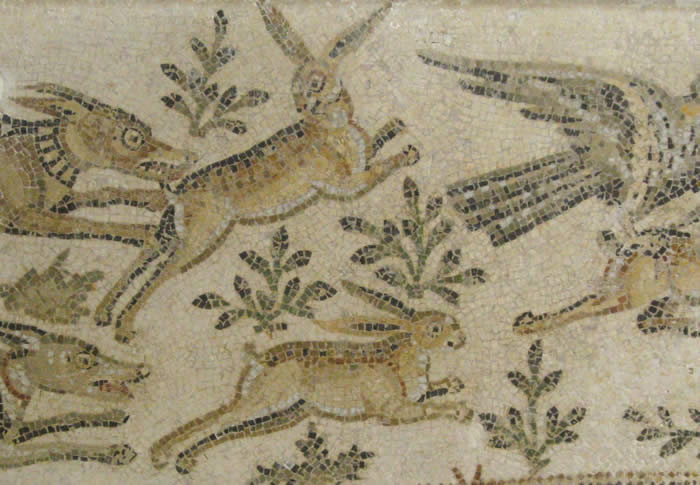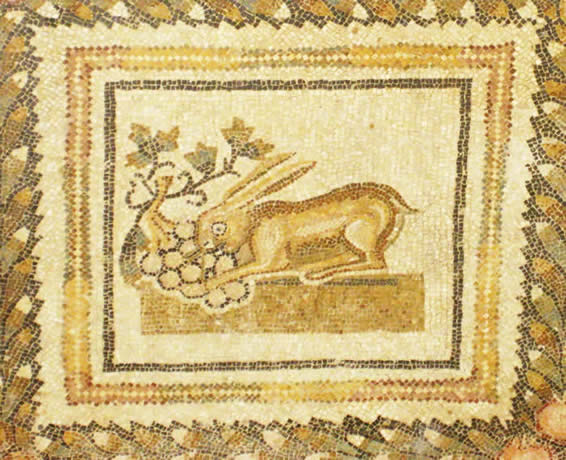RABBIT AND HARE
The main thing to note about rabbit is that wild and farmed rabbit need to be cooked in quite different ways. Farmed rabbit (which is what is commonly sold on the continent) is like chicken and needs perhaps 40 minutes of gentle stewing. The much gamier and tougher wild rabbit normally needs at least an hour and a half .
When you are jointing a rabbit (or asking the butcher to do so), assume that each hind leg makes a portion and the saddle can be divided into two or possibly three pieces. The neck end is mostly bone and can be discarded. The front legs together barely make one portion unless you are dealing with a large farmed rabbit. One wild rabbit does about three or at most four people; farmed ones, which are larger, can do four or five or even six if very large.
MUSTARD RABBIT (for 4-5)
1 farmed rabbit, jointed, or 2 smallish wild rabbits 3 tablespoons flour 3 tablespoons olive oil 4 rashers bacon, diced 4 shallots, peeled and sliced ¼ pint/150ml dry white wine ¼ pint/150ml chicken stock 1 tablespoon Dijon mustard (or 1 dessertspoon Dijon mustard and 1 dessrertspoon grain mustard) 125-150ml cream (preferably crème fraȋche) thymechopped fresh tarragon salt, pepper, bay-leaf,
Put the flour, salt and pepper in a plastic bag with the rabbit pieces and shake until the rabbit is well coated. Heat the olive oil in a casserole or saucepan. Add the bacon, shallots and rabbit pieces, browning the rabbit on all sides. Add the wine, stock, bay-leaf and theyme. Simmer until tender (at least 1½ hours for wild rabbit; ¾ hours for farmed rabbit). Then mix together the cream and mustard, stir into the rabbit, sprinkle with the tarragon and serve.
RABBIT WITH OLIVES (for 5-6)
This recipe is a slightly adapted version of one from a book of Tuscan cooking by Leslie Forbes.
3 lb/1.5kg farmed rabbit, jointed 2 cloves garlic, peeled and slashed 4 fluid oz/120 ml white wine 1 tablespoon tomato paste 6 tablespoons pitted black olives 8 fluid oz/220ml stock olive oil, salt, pepper
Brown the rabbit and garlic in a generous amount of olive oil. Add the wine and turn up the heat to evaporate it almost completely. Add the tomato paste and stock and simmer, covered, for 15 minutes. Add the olives, salt and pepper. Simmer for a further 25-30 minutes until tender.
RABBIT WITH WHITE BEANS (for 4-6)
This recipe is adapted from one published by the excellent Simon Hopkinson in the Independent.
1 large wild rabbit, jointed300-400 dried white beans, soaked overnight 1 teaspoon coriander seeds, crushed 8 cloves garlic, peeled and crushed 4 bay-leaves 150-200 ml dry sherry chopped parsley, olive oil, salt, pepper.
Brown the rabbit pieces on all sides in an oven-proof casserole with a generous amount of olive oil. Add the coriander seeds and garlic and mix around, cooking for a couple more minutes. Add the drained beans, bay-leaves and sherry. Cover with water and bring to a simmer. Cover the casserole tightly with foil and a lid, and cook in an oven pre-heated to gas mark 2/150º for 1½-2 hours, or until beans are done and rabbit is tender. Stir in some chopped parsley and serve.
From a Roman mosaic in Tunisia
HARE WITH WHITE WINE AND CREAM (for 5) A hare is perfect for 5 people, with the two large hind legs each serving as a portion; the saddle cut into two providing two more portions; and the two skinny front lags together making one portion. The ribcage, which has little meat, can be discarded. 1 hare with its liver, cut into portions (keep the liver and cut it into slices) Olive oil, butter, salt and pepper Brown the hare pieces in some olive oil and reserve. Gently sauter the lardons, shallots, bay and thyme with some olive oil to a casserole or large saucepan. Add the crushed garlic, the hare pieces and the white wine, salt and pepper. Bring to a simmer and cook gently, covered, for one hour. Meanwhile, in a food processor or spice grinder reduce the liver and onion to a rough purée. Brown the purée in a little butter and leave to cool. Once cool, blend or stir in the crème fraiche. Add the mixture to the casserole once the hare has cooked for an hour. Cook for a further half hour or until the hare is tender, turning the pieces so that the upper parts do not get too dry. Sauter the mushrooms in a little olive oil or butter and add to the stew before serving.
CIVET DE LIEVRE (for 6)
1 hare, cut into pieces, saving any blood and liver 1 bottle of red Burgundy or similar 2 tablespoons brandy 10 cloves garlic, peeled and crushed 5 bay leaves 3 onions, peeled and sliced zest of 1 lemon (optional) 6 rashers streaky bacon, diced 2-4 squares of 70% dark chocolate 2 tablespoons tomato purée 10 clove heads, crushed olive oil, flour, salt and pepper
Marinate the hare overnight in the wine with the brandy, garlic, bay leaves, onions, lemon zest and a good dollop of olive oil. Remove the hare pieces from the marinade and dry with kitchen towels. Put 6 tbsp flour in a plastic bag with salt and pepper, add the hare pieces and shake to coat. Fry the bacon in some olive oil and reserve. Brown the hare pieces on both sides and reserve. Add the strained marinade to the pan, scraping up the residue of flour, and bring gently to a simmer. Add the tomato purée, chocolate and clove heads and stir until it is all melted together. Put the hare and bacon in an oven-proof casserole, pour the marinade over the top, plus enough water to almost cover the hare, and season with salt and pepper. Cover well with foil and a lid and cook for three hours in an oven preheated to 140º C/gas mark 3, adding water if the sauce becomes too thick. The meat can if desired be removed from the bones after cooking, to make it easier to eat. If there is any saved blood from the hare, this can be used to thicken the sauce. Add some of the hot sauce gradually to the blood and then pour back into the casserole, bringing it just back to the boil. It there is no blood, the raw liver can be puréed and used to thicken the sauce in the same way. Otherwise the liver can be briefly fried and added to the casserole at the last moment (it gets hard if over-cooked). Serve with mashed potato.
ROAST SADDLE OF HARE (for 2) 1 saddle of hare Wrap the saddle in the strips of bacon. Place in a snug roasting dish and cover with the butter. Roast for 40 minutes in an oven pre-heated to gas mark 7/220° C. Remove the saddle and place in a warm serving dish while you make the sauce. Spoon the redcurrant jelly into the roasting dish set over a low heat, and stir until melting. Add the sour cream and continue stirring until all is smooth. Grind in a liberal amount of pepper. Carve the saddle lengthwise like a duck breast, and pour the sauce over the slices. (Jennifer Paterson.)
|

